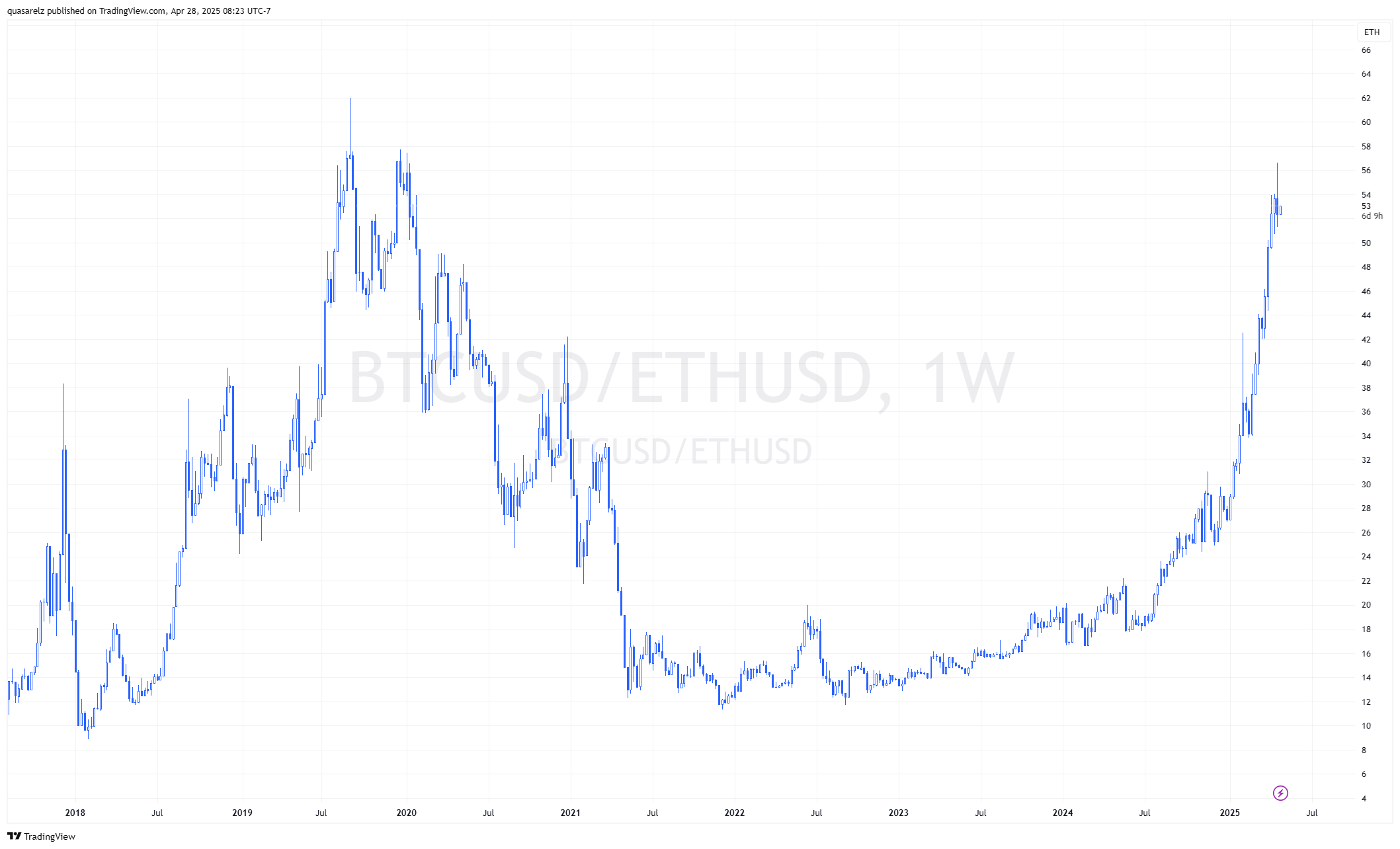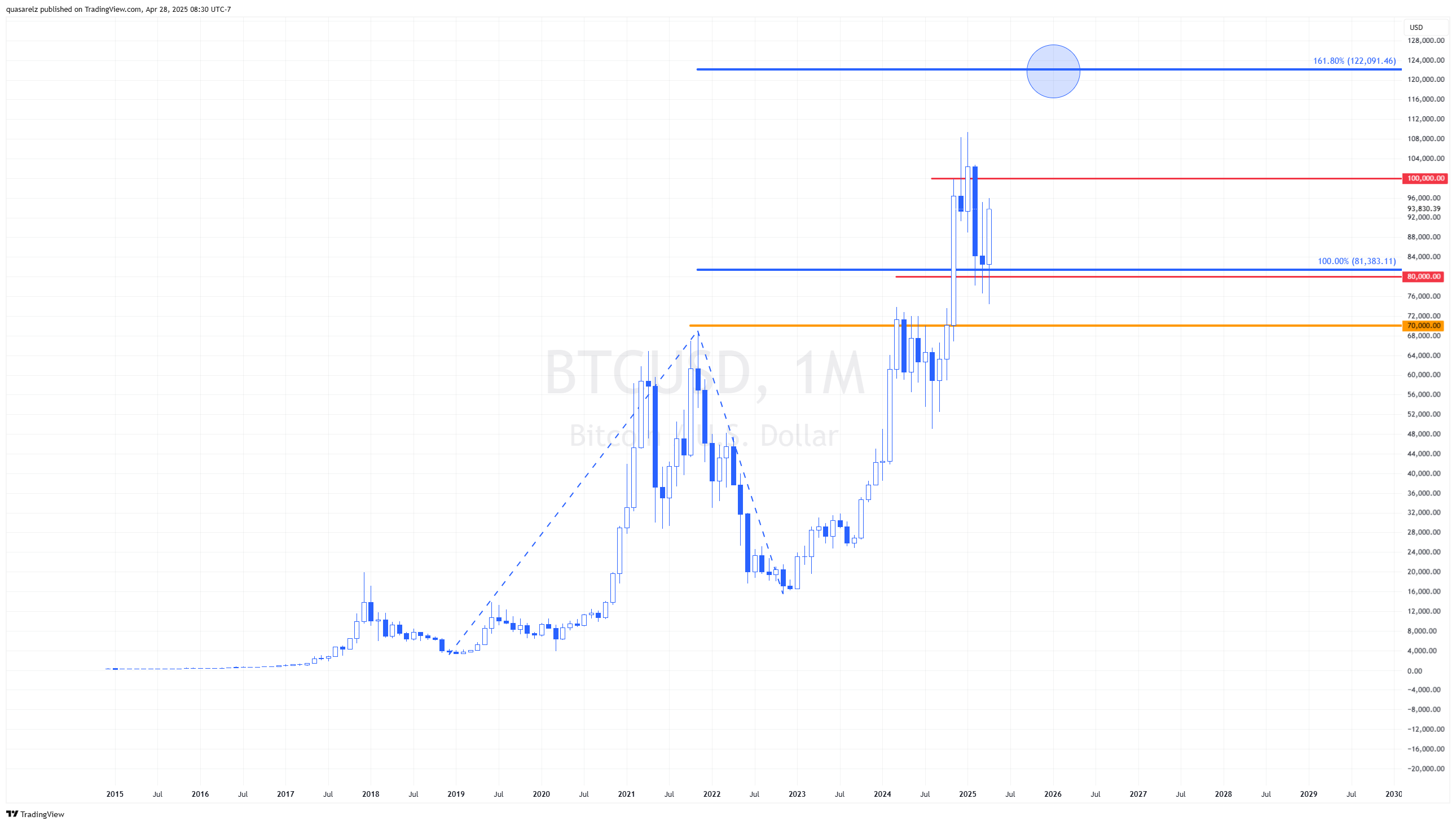- English
- 中文版
Bitcoin vs. Ethereum: The Great Divide of 2025 – Institutionalization, Regulation, and Liquidity at Odds

While the broader market has navigated turbulent waters, marked by persistent macroeconomic uncertainty and geopolitical tensions fueled by trade wars, the performance and adoption gap between BTC and ETH has widened to levels not seen in years.
The BTC/ETH Ratio: An Extreme Indicator
A key barometer of this separation is the BTC/ETH price ratio, which has reached levels close to 54, an extreme reading not observed since the pre-pandemic days. This ratio highlights an undeniable reality: Bitcoin and Ethereum's paths have diverged significantly in terms of market perception, capital flows, and regulatory favor this year.
BTC/ETH Relative Weekly Chart:

The Broken Myth of "Digital Gold" in 2025
It is crucial to emphasize that in a year fraught with uncertainties, neither of the two leading cryptocurrencies fulfilled the promise of being a safe-haven asset or "digital gold." While traditional physical gold reached new historical highs with gains close to 30% in 2025, Bitcoin barely maintained a symbolic 1% year-over-year appreciation. Ethereum, meanwhile, suffered a substantial depreciation of nearly 50%. This sharp difference debunks their role as global volatility hedges and reflects very different internal dynamics.
The Institutional Catalyst: Bitcoin’s Decisive Edge
Much of the explanation lies in institutional support. The approval and resounding success of spot Bitcoin ETFs in the U.S. at the end of 2024 and early 2025 opened the floodgates for massive institutional capital inflows. In April alone, these ETFs attracted approximately $2.8 billion in net inflows within just five days.
In contrast, spot Ether ETFs, launched later, not only failed to replicate this success but also saw net outflows of $228 million in Q1. Ethereum’s more complex regulatory path, particularly regarding staking, cooled institutional enthusiasm.
Regulatory Clarity vs. Persistent Uncertainty
Bitcoin enjoys a relatively clear classification as a commodity in key jurisdictions like the U.S., easing its adoption. The creation of a "Strategic Bitcoin Reserve" by the U.S. Treasury sent a powerful legitimizing signal. Meanwhile, Ethereum remained mired in greater regulatory caution, especially regarding its Proof-of-Stake mechanism and staking-related yield implications.
Liquidity Dynamics and Market Behavior
Bitcoin’s liquidity remained stable (~$500 million within 1% of the median price), even amid external shocks. Conversely, Ethereum’s liquidity deteriorated by 27%, reflecting lower confidence and higher fragility.
Moreover, Bitcoin whales accumulated during dips, while Ethereum whales tended to sell during rallies, adding downward pressure. This fostered a "flight to quality", with Bitcoin benefiting and reaching a market dominance of over 62%, its highest level since 2021.
Future Outlook: Will Ethereum Continue to Lag?
Looking ahead, without a comparable institutional catalyst or greater regulatory clarity, Ethereum may continue to lag. Its narrative around utility (DeFi, NFTs, etc.) has lost momentum in a risk-averse macro environment where Bitcoin’s simplicity and quasi-institutional status prevail.
Conclusion
2025 failed to establish Bitcoin as global "digital gold," but it positioned it as the preferred reserve asset within the digital ecosystem, buoyed by institutional inflows and greater regulatory certainty. Ethereum, despite its ongoing innovation, faces the challenge of attracting similar trust in a setting that rewards simplicity and perceived safety. The Great Divergence of 2025 teaches that institutional adoption and regulatory clarity are now the decisive arbiters of success in the mature digital asset era.
BTC/USD Monthly Chart:

The material provided here has not been prepared in accordance with legal requirements designed to promote the independence of investment research and as such is considered to be a marketing communication. Whilst it is not subject to any prohibition on dealing ahead of the dissemination of investment research we will not seek to take any advantage before providing it to our clients.
Pepperstone doesn’t represent that the material provided here is accurate, current or complete, and therefore shouldn’t be relied upon as such. The information, whether from a third party or not, isn’t to be considered as a recommendation; or an offer to buy or sell; or the solicitation of an offer to buy or sell any security, financial product or instrument; or to participate in any particular trading strategy. It does not take into account readers’ financial situation or investment objectives. We advise any readers of this content to seek their own advice. Without the approval of Pepperstone, reproduction or redistribution of this information isn’t permitted.